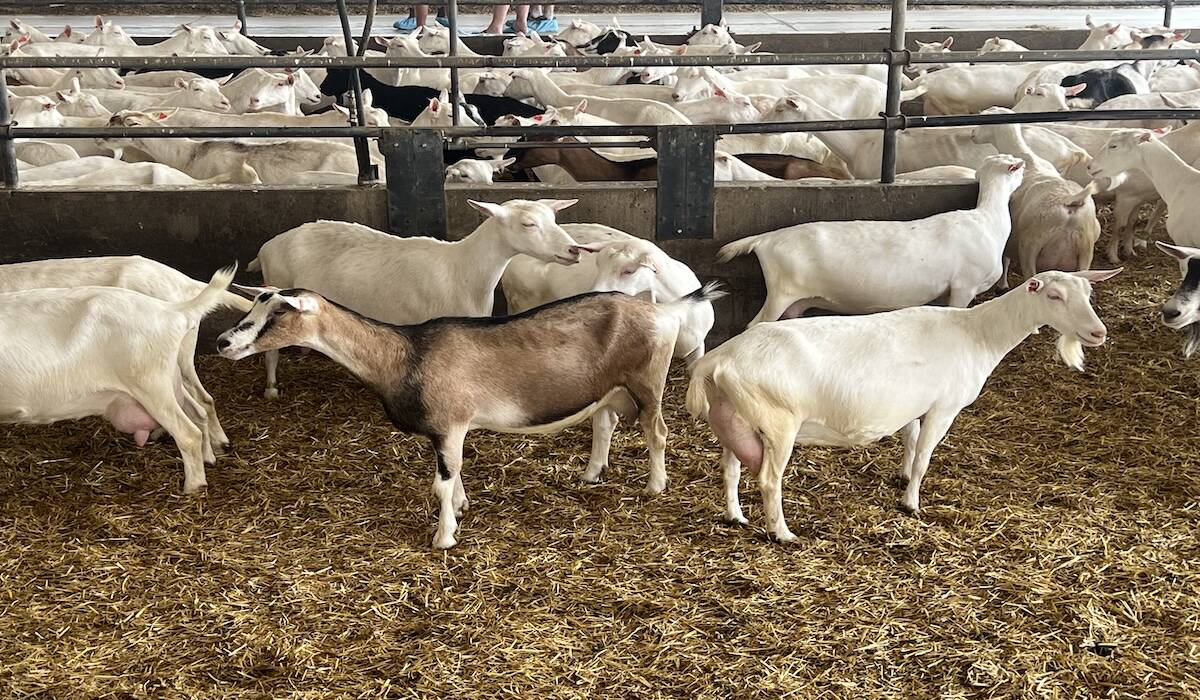Statistics Canada released its second model-based yield and production estimates Sept. 14. Its model evaluated conditions as of Aug. 31 using satellite technology and agroclimatic data.
Soybean yields were unchanged from its earlier estimate, while corn yields were raised by over three bu./acre. A marginal upward revision was noted in winter wheat.
Quick look:
Read Also

Ontario dairy goat producers move toward forming provincial board
Creation of a Dairy Goat Board under the Ontario Farm Products Marketing Commission may be voted on by early 2026.
Soybeans: StatCan modelling holds total soybean production at four million tonnes.
Corn: Ontario’s yield estimate has been increased to more than 9.7 million tonnes.
Wheat: Ontario’s winter wheat production is up from the five-year average at 2.6 million tonnes.
From Aug. 14 through Sept. 14, the region east and north of Toronto received 60 to 85 per cent of normal precipitation. The growing region west and south of Toronto received 85 to 114 per cent of normal precipitation. Row crops had favourable conditions in the final stages of development.
We’re expecting StatCan’s final crop farmer survey, which will be released Dec. 4, to show higher yields than the model estimates.
Ontario farmers typically sell 50 to 60 per cent of their corn, 70 per cent of their soybeans and 80 per cent of their wheat by Dec. 31. There will be pressure on basis levels over the next two months as commercial stocks balloon.
The USDA lowered its corn and soybean yields in its September World Agriculture Supply and Demand Estimates (WASDE) report. A downward revision was noted in soybean production. Corn production was raised due to an increase in planted and harvested area.
There was no significant change to fundamental projections. The U.S. corn and soybean harvests will occur at a rapid pace due to weather-induced maturing. The last half of August and first half of September were hot and dry across the Midwest.
Downward yield revisions are expected in subsequent WASDE reports. Brazil and Argentina are in the early stages of corn planting and recent rains have enhanced soil moisture conditions. Brazilian farmers have started planting soybeans but Argentine farmers will plant soybeans next month.
Seasonal lows are likely in place for the wheat market. Export demand for Ontario and U.S. soft red winter wheat is expected to increase later in fall. Combined ending stocks of the seven major wheat exporters are expected to be down 30 million tonnes from last year.
The Canadian dollar has traded in the range of 73 to 74 U.S. cents during the first half of September. Seasonally, it trades sideways during the final quarter of the year. Demand for resources/commodities has decreased due to the economic slowdown in China, India and Europe. However, crude oil prices are trading near 52-week highs and the energy markets have divorced from other commodities. The weaker Canadian dollar along with stronger biofuel prices will be supportive for Ontario corn and soybean markets.
Soybeans
StatCan’s model-based crop estimate had Ontario soybean production near four million tonnes, unchanged from its previous forecast. We continue to forecast a crop size in the range of 4.2-4.3 million tonnes, which would be up from last year’s crop of four million tonnes.
The domestic crusher has lowered its basis in anticipation of harvest selling pressure. At the same time, export demand has increased over the past month. Bids from domestic crushers are only 20-30 cents/bu. higher than local elevator bids. The domestic crusher premium over elevator bids tends to peak from March through May and is typically in the range of 60-80 cents during these three months.
At the time of writing this article, Brazilian soybeans were valued at US$516/tonne f.o.b. Paranagua while U.S. offers were reported at $532/tonne. Brazilian soybeans are at a minor discount to U.S. origin until November. Then U.S. soybeans take over dominant position.
Ontario offers are US$10/tonne discount to U.S. origin for November. Ontario soybeans are competitive into Chinese, European and North African destinations. We expect limited downside through the harvest period.
The USDA estimated soybean production at 112.8 million tonnes in its September WASDE report. This was down from the previous estimate of 114.5 million tonnes and down from the 2022 crop of 116.3 million tonnes. We’re expecting further downward yield revisions on subsequent crop surveys with the final production estimate eventually finishing near 110 million tonnes.
Farmers in Brazil and Argentina are in the early stages of planting. Recent rains have aided moisture conditions but timely rains are needed to sustain yield potential.
During November and December, the futures market will incorporate a risk premium due to uncertainty in production. Our forecast calls for normal to below normal precipitation during the key growing period. The market is factoring in a year-over-year increase in South American production but we believe this is premature.
What to do: Earlier in spring, we advised Ontario farmers to be 20 per cent sold on their 2023 production. There is no change to our strategy. We’re planning our next sale in late October or November. The soybean market has potential to strengthen after the North American harvest. If drier conditions materialize in South America, there will be stronger demand for North American soybeans.
Corn
StatCan bumped up its Ontario corn production estimate from 9.565 million tonnes in its July 31 estimate to 9.745 million tonnes in the Aug. 31 forecast. Its model-based survey tends to underestimate yields in wet years. Our contacts continue to report yields suggesting a crop size of 10.1 million tonnes. The Ontario corn market will function to encourage demand in the first five months of the crop year. Basis levels are under pressure.
Ethanol margins have improved and we’re expecting a year-over-year increase in ethanol production. Cattle feeders have experienced a favourable summer. Ontario feeding margins have been higher compared to Alberta feedlots due to lower corn prices. We’re anticipating a year-over-year increase in Ontario feedlot inventories this winter and total cattle on feed numbers make seasonal highs during January through March.
European demand for Ontario corn will be higher in 2023-24 compared to the 2022-23 campaign. The bulk of this buying interest will surface from March through May. There is a strong case to sell the bulk of the corn in the latter half of the crop year.
At the time of writing this article, Brazilian corn was valued at US$228/tonne f.o.b. Paranagua while U.S. corn was quoted at US$245/tonne f.o.b. the Gulf for November loading. Ontario corn was on the world market at US$230/tonne f.o.b. St. Lawrence port and French corn was offered at US$230/tonne f.o.b. La Palice.
The European Union decided not to renew a ban on Ukrainian agriculture products flowing the neighbouring countries on Sept. 15. This pressured European corn and wheat prices, especially in countries closer to Ukraine.
The USDA lowered its corn yield but raised harvested area in its September WASDE report. U.S. corn production is now estimated at 343.4 million tonnes, up from the August number of 383.8 million tonnes and up from the 2022 output of 348.8 million tonnes. We’re expecting another downward revision to yields on upcoming surveys and feel comfortable with our estimate of 377 million tonnes. The main point is that the U.S. corn crop is getting smaller, not bigger.
In South America, Brazil’s first-crop corn is about 15 per cent planted while farmers in Argentina have just started. The bulk of Brazil’s exportable surplus comes from the second crop, which is only planted in January and February.
Argentina is coming off a recent drought and a large part of the country remains on the dry side. China has been in the market for U.S. corn and this is somewhat surprising at this stage of the crop year. The trade is skeptical about Chinese yields and quality.
What to do: We’ve advised Ontario farmers to be 20 per cent sold on their 2023 production. We believe the corn market is in the process of making a seasonal low. Farmer selling will decrease later in winter and demand for Ontario corn makes a seasonal high in early spring.
Wheat
There was no change to Ontario wheat production on the latest government crop estimate. Production was left at 2.6 million tonnes, up from the 2022 crop size of 2.2 million tonnes and up from the five-year average of 21 million tonnes. Given the current price structure, feed and milling quality wheat is priced competitively into domestic feed channels.
Export demand for soft red winter wheat is anemic, to say the least. Basis levels for milling quality have been sluggish. However, the downward potential in the Ontario wheat market is limited and we’re anticipating stronger prices later in fall.
On Sept. 15, U.S. No. 2 soft red winter wheat was offered at US$259/tonne f.o.b. the Gulf and French soft wheat was quoted at US$250/tonne f.o.b. Rouen. Ontario wheat was quoted at US$225/tonne f.o.b. St. Lawrence port. On Sept. 5, Egypt bought 500,000 tonnes of Russian wheat at US$270/ tonne C+F (C+F equals costs and vessel freight and is the delivered price to the destination port).
Ontario wheat is competitive with other major exporters but Russia appears to be saturating all major markets for the time being. U.S. soft red winter wheat appears dominant in the Caribbean and Central America.
The Russia-Ukraine conflict continues to escalate. Ukrainian exporters are struggling to move wheat through the Black Sea and via third countries. The wheat market isn’t paying attention to this conflict and major infrastructure damage barely makes news headlines. There is no war risk premium in the wheat market at this time. Perhaps this may come later in the crop year if exports out of Russia start to ease.
To reiterate from our previous issue, we believe the wheat market is in the process of making seasonal lows. The Northern Hemisphere winter and spring wheat harvests are wrapped up. Russia is contending with a large volume of feed quality wheat, which may temper exports later in the crop year. China is in a similar situation after adverse rains during harvest. India will be a major importer in the 2023-24 crop year after exporting wheat in the past two years.
We can also argue that combined wheat stocks from the seven major exporters at the end of the 2023-24 crop year will drop to the lowest levels since 2007-08. The next major harvests will be from Australia and Argentina. Australian wheat output was estimated at 26 million tonnes by the USDA but private analysts have the crop in the range of 22-23 million tonnes. This is down from 40 million tonnes last year.
Argentine output will likely finish in the range of 15-16 million tonnes, up from 12.5 million tonnes last year. Argentine exports are uncertain due to political issues. The world cannot afford a crop problem with Northern Hemisphere wheat in 2024.
What to do: We continue to recommend that producers hold back on sales. Our first recommendation will likely occur in October and November. If you have feed quality wheat, it’s prudent to move 20-30 per cent because the feed wheat market has limited upside given larger production this year.















